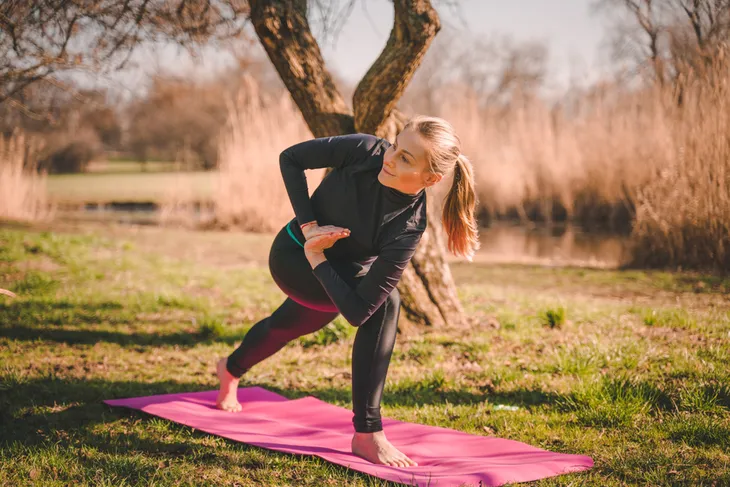Runners tend to love their workouts and put considerable time and thought into the run itself. But when it comes to stretching afterwards, many are a little bit slap dash in their approach. Maybe they’ve had the same stretching routine for years, which can certainly lead to decreasing benefits and more than likely skips some of the lesser-known muscles.
This is when and where there is a great opportunity for yoga moves to stretch, strengthen, and optimize runner’s workouts. Here are the eight of the best yoga moves for runners…
Dancer’s Pose
This is a great stretch for the muscles on the front of the leg, from the quadriceps to the hip flexors. Even beginners will feel a deep stretch by merely pushing the top of the back foot in the hand and counterbalancing by leaning forward.
Another bonus is that this is a balance pose that works on the mechanoreceptors in the ankle. These make the ankles better able to deal with any stability—from an icy patchy to a steep trail which means less chance of rolling and spraining an ankle.
High Lunge (With Prayer Twist)
The key here is a long, straight back leg, which stretches both the hip flexor and the upper insertion of the quadriceps while the muscles are in an elongated position. Hamstrings also benefit from a stretch here, while the front leg is strengthened.
Adding the twist by hooking an elbow over the opposite knee shifts the focus of this stretch nicely to the outer part of the front leg. Side glutes and the IT band get a good stretch, which is nice for runners who are often tight in these areas.
Downward Dog
This is a fantastic stretch to loosen and lengthen the hamstrings and calves. Performing the pose with the feet closer to the hands emphasizes the hamstrings more, while increasing the space between the hands and feet switches the emphasis to the gastrocnemius muscle in the calf.
By “walking the dog” or bending alternating legs, the stretch moves to the smaller and shorter soleus muscle in the calf. It also helps increase range of motion and helps make it increasingly possible for the heels to reach the floor.
Staff Pose
Staff pose stretches the hamstrings, especially with feet flexed. A strap can be used around the feet to get deeper into the stretch. The focus should be hinging from the hips with a straight back.
If this pose is too challenging, it can be modified with one leg bent on the ground in a more classic runners stretch. In this case the emphasis is on the straight leg extended on the floor.
Frog
This bent leg spread-eagled pose feels divine on tight inner thigh muscles. It can be modified by starting in table pose and then just spreading the legs wide enough to the point of gentle tension. After a minute or so in the pose there may be some loosening of the muscles to allow the torso to get closer and closer to the floor.
This is a good pose to stay in for a good 3-minutes. As the muscle tension melts away and muscle fibers loosen, it becomes increasingly comfortable. As well, the weight of the legs pulls lightly on the insertion of the IT band at the knee to allow for a nice stretch.
Pigeon
There’s a reason why there are murmurs of approval from the runners when this pose is done, especially at the end of class. That’s because it is amazing for stretching and releasing tight glute muscles just by using the weight of the body.
Glutes are often sore or tight in runners, especially after running trails, hills, or uneven terrain. There are many muscles in the gluteal region and by varying the angle of the bent leg all of them get a wonderful stretch.
Happy Baby
This delightful pose involves lying supine with bent legs in the air, a mat-width apart. The arms straighten so that the hands can grasp the outer edges of the feet. This provides a nice stretch in the inner thigh and the fingers can provide a mini massage of tired and aching feet, as well.
The inversion is also beneficial for returning blood back to the core rather than pooling in the lower extremities. This elevation helps aid recovery and circulation.
Butterfly Pose
This pose feels so good after a long run. It emphasizes the muscles of the inner thigh. Participants with limited flexibility can modify the pose by placing one crossed leg a hand width in front of the other on the ground, and then switching front legs.
This pose also offers a good opportunity to take some deep breaths, reflect on any lingering areas of tightness, and plan a stretch to relieve the tightness. For that reason, it is a great stretch to do close to the end of a stretching routine.











